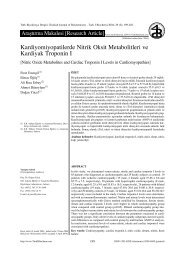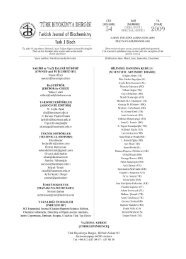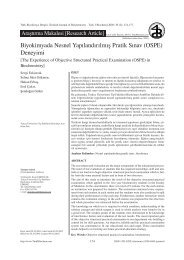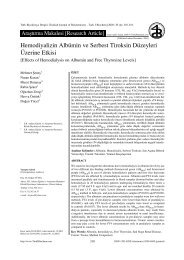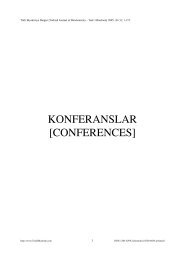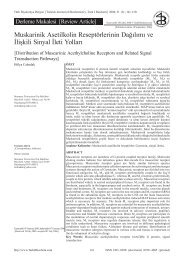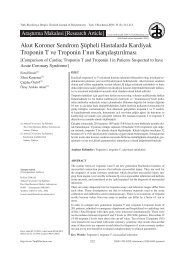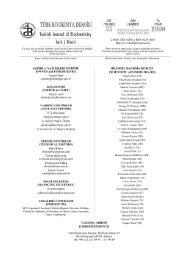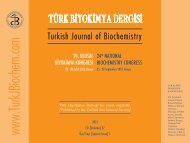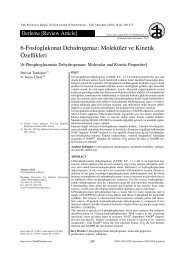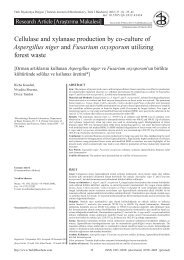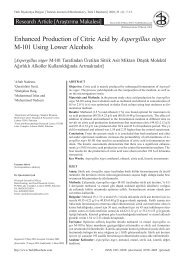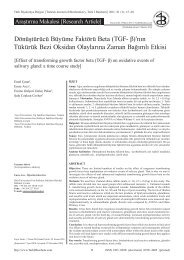23. Ulusal Biyokimya Kongresi Ãzel Sayısı - Türk Biyokimya Dergisi
23. Ulusal Biyokimya Kongresi Ãzel Sayısı - Türk Biyokimya Dergisi
23. Ulusal Biyokimya Kongresi Ãzel Sayısı - Türk Biyokimya Dergisi
You also want an ePaper? Increase the reach of your titles
YUMPU automatically turns print PDFs into web optimized ePapers that Google loves.
XXIII. ULUSAL B‹YOK‹MYA KONGRES‹<br />
29 Kasım - 2 Aralık 2011<br />
Hilton Hotel - Adana<br />
<strong>23.</strong> <strong>Ulusal</strong> <strong>Biyokimya</strong> <strong>Kongresi</strong>, Adana [23 rd National Biochemistry Congress, Adana / TURKEY]<br />
İÇİNDEKİLER<br />
P. 206 / MENTHA LONGİFOLİA (L.) HUDSON SUBSP. TYPHOİDES<br />
(BRİQ.) HARLEY’İN BAZI VİTAMİN, İZ ELEMENT DÜZEYLERİ VE<br />
ANTİOKSİDAN ÖZELLİĞİNİN BELİRLENMESİ<br />
Suat EKİN 1 , Mahire BAYRAMOĞLU 1 , Hatice KIZILTAŞ 1 , Fevzi ÖZGÖKÇE 2<br />
Kimya, Yüzüncü Yıl Üniversitesi, Van<br />
Biyoloji, Yüzüncü Yıl Üniversitesi, Van<br />
Birçok bitki içerdiği biyolojik aktif maddeler sayesinde serbest radikal temizleme<br />
etkileri ile antioksidan savunma sistemini düzenler. Bu çalışmanın amacı, mentha<br />
longifolia L. (yabannanesi) bitkisinde bazı vitamin (A, D, E), iz element (Cu, Zn, Fe,<br />
Mn, Fe, Ni), mineraller (Mg, K) ve Antioksidan özelliğinin belirlenmesidir. Yapılan<br />
Çalışmada vitamin değerleri HPLC yöntemine göre, iz element ve mineraller atomik<br />
absorbsiyon spektrofometre ile antioksidan özelliği ise bitkinin metanol ekstraktında<br />
DPPH, süperoksit serbest radikal temizleme, hidrojen peroksit temizleme aktivitesi,<br />
toplam fenolik bileşen ve flavonoid miktarı ile spektrofotometrik olarak belirlendi.<br />
Yapılan çalışmada bitkinin metanol ekstarktında antioksidan özelliğini belirlenmesi<br />
için pozitif kontol olarak (trolox, a-tokoferol) ile karşılaştırıldı. Serbest radikal<br />
temizleme özelliğini DPPH yöntemine göre belirlerken DPPH radikalini % 50 inhibe<br />
eden konsantrasyon değerleri (IC50) hesaplandı. Bulunan sonuçlardan bitkinin<br />
yüksek derecede antioksidan özelliğe sahip olduğu vitamin ve iz element düzeyleri<br />
de bu özelliği destekler nitelikte olduğu tesbit edilmiştir. Bu bitkinin ileride yapılacak<br />
çalışmalarda hayvan modellerinde deneysel olarak oluşturulacak oksidatif stresin<br />
sonucunda oluşan serbest radikallere karşı antioksidan olarak kullanılanılacağı<br />
düşünülmektedir.<br />
P. 206 / THE DETERMINATION OF SOME VITAMIN, TRACE<br />
ELEMENT LEVELS AND ANTIOXIDANT PROPERTY OF MENTHA<br />
LONGIFOLIA (L.) HUDSON SUBSP. TYPHOIDES (BRIQ.) HARLEY<br />
Suat EKİN, <strong>Biyokimya</strong> 1 , Mahire BAYRAMOĞLU 1 , Hatice KIZILTAŞ 1 ,<br />
Fevzi ÖZGÖKÇE 2<br />
Biochemistry, Faculty of Science Yuzuncu Yıl University, Van<br />
Botanics, Faculty of Science Yuzuncu Yıl University, Van<br />
Biologically active substances which contain many plants regulate antioxidant defense<br />
system in due to the effects of free radical scavenging. The purpose of this study was<br />
to examine, some vitamins (A, D, E), trace element (Cu, Zn, Fe, Mn, Fe; Ni), minerals<br />
(Mg, K) and antioxidant property in Mentha longifolia L. plant. In this study, the<br />
levels of vitamins using the HPLC method, trace elements with atomic absorption<br />
spectrophotometer and the antioxidant properties of methanol extract of the plant with<br />
the DPPH and superoxide free radicals, hydrogen peroxide scavenging activity, the<br />
total phenolic and flavonoid compounds were determined with a spectrophotometer.<br />
For the determination of plant methanol extract in the study of antioxidant property<br />
were compared with positive controls such as trolox, a-tocopherol. When determining<br />
free radical scavenging property according to the method DPPH, the concentration<br />
values that inhibits 50 % of DPPH radical (IC 50) was calculated. The findings of<br />
this study showed a high degree of antioxidant property, vitamin and trace element<br />
levels were also found to support this feature. This plant is thought to be used as<br />
an antioxidant in future studies of experimental animal models, against free radicals<br />
generated in response to oxidative stress.<br />
CONTENTS<br />
Turk J Biochem, 2011; 36 (S2)<br />
http://www.TurkJBiochem.com



